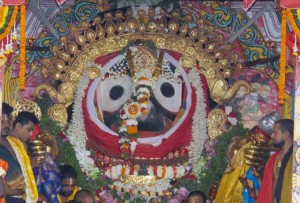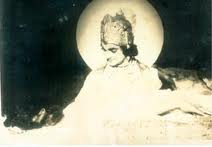Introduction
The Baisi Pahacha, or the 22 steps, hold a significant place in the Sri Jagannath temple in Puri. These steps connect the Lion’s Gate (Singhadwara Gumuta) to the second gate (Baisi Pahacha Gumuta) inside the temple. While historical records do not pinpoint the exact time of their construction, legends attribute their creation to a king named Bhanudev.
The Structure and Symbolism
The Baisi Pahacha begins just after passing through the Lion’s Gate of the temple. Pilgrims must ascend these steps to reach the second gateway, which leads to a courtyard providing access to the main temple. Each step measures 70 feet in length, 6 feet in width, and 6-7 inches in height. One of the steps, the third one, is particularly significant as it contains a stone called “Yamashila.” Stepping on this stone while ascending is believed to absolve devotees of sins punishable by Yama (the god of death), but stepping on it while descending supposedly negates the merits gained from having darshan (sight) of Lord Jagannath.
Spiritual and Ritual Significance
The Baisi Pahacha is not just a physical ascent but a spiritually enriching experience:
- Holy Activities: During the car festival, the steps are believed to host various gods, goddesses, demigods, heavenly entities, ancestral souls, Chitragupta (Yama’s assistant), and Yamadootas (messengers of Yama). They descend to witness the Pahandi (procession) of Lord Jagannath.
- Pinda Daan: Annual rituals for offering food to ancestors, known as pinda daan, are performed on both sides of these steps. It is believed that the ancestors’ souls are satiated by these offerings. Madan Mohan, a representative idol of Lord Jagannath, performs pinda daan on these steps to honor his ancestors and significant historical figures like King Indradyumna and Queen Gundicha.
- Deepavali Ritual: On Deepavali, devotees burn kaunria kathi (bundles of light sticks) and show them upwards, illuminating the path for ancestral souls. This ritual, known as Badabadia Daka, honors the elders.
- Jainism Connection: Followers of Jainism consider the 22 steps symbolic of their 22 Tirthankars (spiritual teachers).
- Steps of Self-Control: Some interpretations suggest that the 22 steps represent the 22 weaknesses and faults in human beings. Thus, it took some noble men, saints, and Vaishnavas approximately 22 years to conquer these weaknesses and become eligible for Lord Jagannath’s darshan. Scholars thus refer to these steps as ‘the steps of self-control.’
- Preta Shila: The seventh step contains a stone called Preta Shila or Pitrushila. Devotees leave Anna Mahaprasad (holy rice offered to Lord Jagannath) on it to feed the ancestors, believed to liberate the souls of the deceased.
Lessons to Be Learned
- Faith and Devotion: The Baisi Pahacha symbolizes the importance of faith and devotion. Each step taken by the devotees represents their spiritual ascent and their quest for divine blessings.
- Honoring Ancestors: The rituals performed on these steps emphasize the importance of remembering and honoring one’s ancestors, acknowledging their role in our lives.
- Self-Control: The concept of the steps representing human weaknesses teaches us the importance of self-control and personal growth in the journey towards spiritual enlightenment.
- Unity in Diversity: The inclusion of Jain interpretations highlights the underlying unity among different faiths and the universal pursuit of spiritual goals.
Teaching from Srimad Bhagavatam
Srimad Bhagavatam 7.5.23-24:
śrī-prahlāda uvāca
śravaṇaṁ kīrtanaṁ viṣṇoḥ smaraṇaṁ pāda-sevanam
arcanaṁ vandanaṁ dāsyaṁ sākhyam ātma-nivedanam
iti puṁsārpitā viṣṇau bhaktiś cen nava-lakṣaṇā
kriyeta bhagavaty addhā tan manye ‘dhītam uttamam
Prahlāda Mahārāja said: “Hearing and chanting about the transcendental holy name, form, qualities, paraphernalia, and pastimes of Lord Viṣṇu, remembering them, serving the lotus feet of the Lord, offering the Lord respectful worship with sixteen types of paraphernalia, offering prayers to the Lord, becoming His servant, considering the Lord one’s best friend, and surrendering everything unto Him (in other words, serving Him with the body, mind, and words) — these nine processes are accepted as pure devotional service.”
This verse emphasizes the nine processes of devotional service, which can help one achieve spiritual perfection.
Teaching from Caitanya Caritamrita
Caitanya Caritamrita, Antya-lila 4.70:
‘nāma’ vinu kali-kāle nāhi āra dharma
sarva-mantra-sāra nāma, ei śāstra-marma
“In this Age of Kali, there is no other religious principle than the chanting of the holy name, which is the essence of all Vedic hymns. This is the purport of all scriptures.”
This verse highlights the significance of chanting the holy name as the primary means of spiritual practice in the current age.
Teaching of Srila Prabhupada
Srila Prabhupada said: “Real success in life means knowing who you are, who God is, and your relationship with Him. This is self-realization, and this is the goal of human life.” (Lecture on Bhagavad-gita 2.13, Hyderabad, November 21, 1972)
This teaching underscores the importance of self-realization and understanding our relationship with God.
Prayer
O Lord Jagannath,
Please grant us the privilege of ascending the sacred Baisi Pahacha with faith and devotion.
Help us to honor our ancestors and learn the lessons of self-control and spiritual growth.
May our hearts be filled with reverence and love for You,
And may we always strive to serve You with purity and dedication.
Hare Krishna Hare Krishna Krishna Krishna Hare Hare
Hare Rama Hare Rama Rama Rama Hare Hare
May Your divine grace and blessings be upon us always,
Guiding us towards spiritual enlightenment and eternal bliss in Your presence.
I humbly request all the devotees to please forward and share these moral and instructive stories so that everyone can benefit by hearing about Krishna and His dear devotees.

![Read more about the article The Divine Transformation of the Bhils: The Story of Lord Purusottama and the Bhils [a tribal group]](https://www.bhagavatam-katha.com/wp-content/uploads/2015/04/Jagannath-BHIL-2.jpg)

